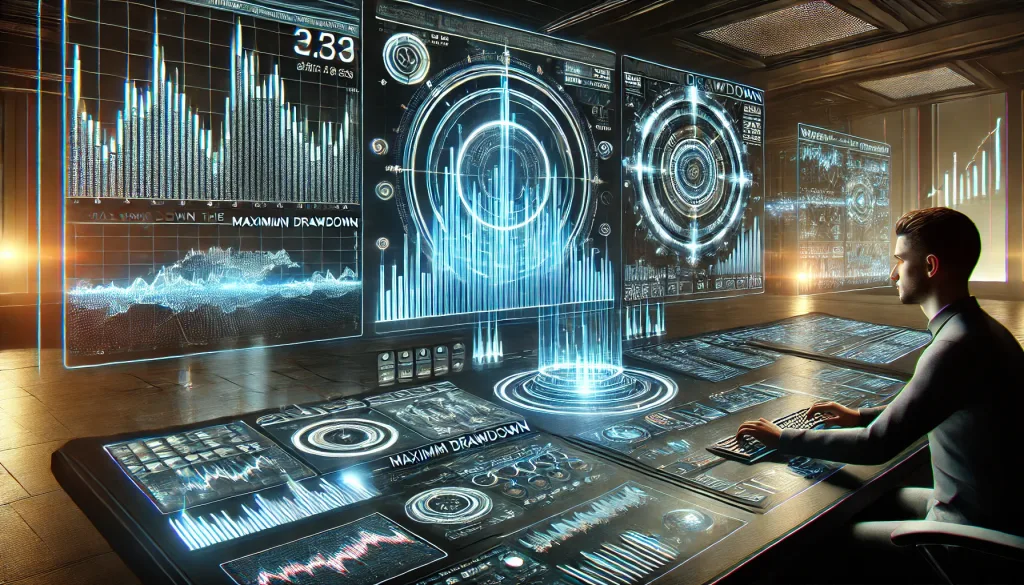The Hidden Power of Bollinger Bands and Maximum Drawdown: The Secret Formula Traders Overlook
Why Most Traders Get It Wrong (And How You Can Avoid It)
Picture this: You’re cruising through the Forex market, feeling invincible. Your trades are going great—until suddenly, the market slaps you with a plot twist straight out of a bad sitcom. Your profits nosedive, and you’re left staring at your screen, wondering if your trading strategy was secretly written by the same people who came up with Game of Thrones‘ final season.
That’s because most traders misunderstand two critical factors that could have saved them: Bollinger Bands and Maximum Drawdown. Let’s break down why these are your new best friends in trading—and how they can prevent your account from looking like a failed startup.
Bollinger Bands: The Trading World’s Crystal Ball
Bollinger Bands are like those friends who tell you when you’re getting too confident at karaoke night—they warn you when you’re pushing your luck.
Developed by John Bollinger in the 1980s, Bollinger Bands measure volatility and provide key insights into potential price reversals. They consist of three lines:
- Upper Band – Typically two standard deviations above the moving average.
- Middle Band – A simple moving average (usually 20 periods).
- Lower Band – Two standard deviations below the moving average.
Here’s what makes Bollinger Bands an essential tool:
- Overbought & Oversold Conditions: When price touches the upper band, it’s often overbought, meaning it might drop soon. The lower band suggests the opposite.
- Breakouts & Fakeouts: If price moves outside the bands, it signals high volatility—but not necessarily a trend reversal. Smart traders wait for confirmation before jumping in.
- The Squeeze: When the bands contract, it means low volatility. This is usually a sign that a breakout is brewing, much like how calm precedes a storm (or an angry toddler’s meltdown).
Pro Tip: Use Bollinger Bands with RSI
Bollinger Bands alone won’t save you from bad trades. Pair them with RSI (Relative Strength Index) to confirm whether the price is truly overbought or oversold before making a move.
Maximum Drawdown: The Silent Killer of Trading Accounts
Maximum Drawdown (MDD) is the worst decline your account has suffered from its peak value. In simpler terms, it’s the deep pit your balance falls into before (hopefully) climbing back up.
Most traders focus on winning trades instead of protecting their capital, and that’s where they go wrong.
How to Calculate Maximum Drawdown:
- Identify your account’s highest balance (the peak).
- Find the lowest balance before it recovers (the trough).
- Use this formula:
MDD = (Peak Value – Lowest Value) / Peak Value × 100%
Example: If your account hit $10,000 and then fell to $7,500 before recovering, your MDD would be:
(10,000 – 7,500) / 10,000 × 100 = 25%
A 25% drawdown is painful, but a 50%+ drawdown? That’s the financial equivalent of setting your wallet on fire.
How to Reduce Maximum Drawdown:
- Use Stop Losses: Always set a stop loss that limits your risk per trade.
- Position Sizing: Never risk more than 1-2% of your capital on a single trade.
- Diversification: Don’t bet everything on one currency pair. Spread your risk.
- Avoid Revenge Trading: If you just lost big, step away. Revenge trades often lead to even bigger losses.
The Secret Strategy: Combining Bollinger Bands & Maximum Drawdown
Now, here’s where the real magic happens. If you combine Bollinger Bands and Maximum Drawdown management, you create a bulletproof trading approach that keeps your losses minimal while maximizing profits.
Step-by-Step Guide to Using This Strategy:
- Identify Bollinger Band Squeezes: When the bands contract, prepare for a breakout.
- Confirm with RSI & Volume: If RSI is above 70 (overbought) or below 30 (oversold), it’s time to act.
- Set a Stop Loss Using Maximum Drawdown Data: Look at past MDD values and set a stop loss that keeps risk manageable.
- Use the Bands as Profit Targets: If you enter on a breakout, aim for the opposite band as your take-profit target.
- Adjust Position Sizes Based on Drawdown History: Reduce trade size if your account has suffered a significant drawdown recently.
Final Thoughts: Mastering the Art of Survival
Trading isn’t just about making money—it’s about keeping it. Bollinger Bands show you when to enter and exit, while Maximum Drawdown ensures you don’t wipe out your account in the process.
Want to take this to the next level? Get real-time insights, elite strategies, and exclusive Forex tools by joining StarseedFX Community today.
—————–
Image Credits: Cover image at the top is AI-generated
PLEASE NOTE: This is not trading advice. It is educational content. Markets are influenced by numerous factors, and their reactions can vary each time.

Anne Durrell & Mo
About the Author
Anne Durrell (aka Anne Abouzeid), a former teacher, has a unique talent for transforming complex Forex concepts into something easy, accessible, and even fun. With a blend of humor and in-depth market insight, Anne makes learning about Forex both enlightening and entertaining. She began her trading journey alongside her husband, Mohamed Abouzeid, and they have now been trading full-time for over 12 years.
Anne loves writing and sharing her expertise. For those new to trading, she provides a variety of free forex courses on StarseedFX. If you enjoy the content and want to support her work, consider joining The StarseedFX Community, where you will get daily market insights and trading alerts.
Share This Articles
Recent Articles
The GBP/NZD Magic Trick: How Genetic Algorithms Can Transform Your Forex Strategy
The British Pound-New Zealand Dollar: Genetic Algorithms and the Hidden Forces Shaping Currency Pairs
Chande Momentum Oscillator Hack for AUD/JPY
The Forgotten Momentum Trick That’s Quietly Dominating AUD/JPY Why Most Traders Miss the Signal
Bearish Market Hack HFT Firms Hope You’ll Never Learn
The One Bearish Market Hack High Frequency Traders Don't Want You to Know The


